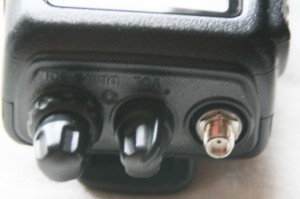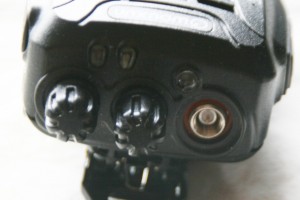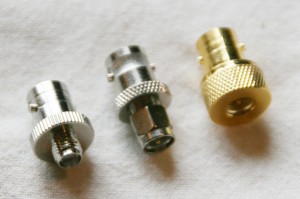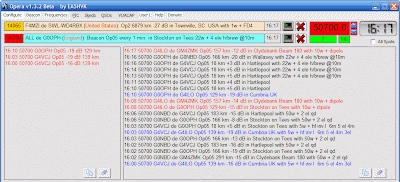Posts Tagged ‘VHF’
 As the skyline changes…
As the skyline changes…
Here in Manhattan, the highest point above the hustle and bustle, is the Empire State Building. Or, it was at least until yesterday. As of April 30th, 2012, the new One World Trade Center is officially the tallest building in Manhattan. As I listened to the news yesterday morning this got me thinking about the antennas on the Empire State Building, and the logistics and history of them. For those of you fascinated by these things, here are a collection of resources to consult, and some of what I learned about the tallest antennas in the city.
I found a great article on the history of the TV mast at www.lnl.com/esbantennas.htm. The TV antenna portion was originally a mooring mast for dirigibles which was re-purposed 8 months after the building was completed in 1931. The article was a reprint from Broadcast Engineering magazine, August 1967. The mooring mast, which was part of the original design of the building, was supposed to be used by passenger airships for anchoring, while the passengers disembarked down a gangplank to the 102nd floor. In reality, this proved to be unsafe, as the updrafts and other air currents around the building would not allow for safe mooring. Only one dirigible ever successfully anchored to the mast after a 30 minute ordeal with mooring ropes, and even then was only able to stay anchored for 3 minutes. The first entity to transmit from the re-purposed mast was NBC who began experimental TV transmissions from the ESB in December of 1931. For you fans of TV’s Fringe, the sequences shot in the alternate universe, show modern dirigibles moored to the Empire State Building, as well as a skyline that still contains the Twin Towers.
Here also, is another great article; from CQ Amateur Radio, March 2011, Digging Deeper With Bill Baker, W1BKR, where Bill visits the transmitter site for channel 13, WNET, in the Empire State Building. Great pictures of the mast, and of the massive filter network that all signals have to pass through first to reduce interference with each other.
Today there are over 130 antennas on the Empire State Building at various heights. This site lists the options available to anyone interested in locating an antenna up there. I’m not sure how many Amateur Radio repeaters are on the building as of today, but one I know for sure is KQ2H. KQ2H has a large linked network of repeaters that give it incredible range, including a 10 meter input up in the catskill mountains. I can listen to the ESB 220, 440, and 900 repeaters from my desk at work, and get an idea of what’s going on with 10 meter propagation by taking note of where the incoming stations are. Lately I’ve been hearing hams from Australia and New Zealand hitting the repeater late nights between 8 and 10 PM EDT. KQ2H’s 10 meter FM machine transmits on 29.620, and listens on 29.520. It is usually available on EchoLink, although the link has been down lately. On EchoLink you need to search for the callsign W2FLA which belongs to the linked 2 meter repeater in the system up in the mountains.
Many of these entities that have antennas on the ESB, relocated there after the Twin Towers fell in the 9/11 disaster. I was looking for antenna leasing info for the new One World Trade Center building, but nothing seems to be posted yet. There is definitely going to be an antenna structure on the top of the building though. I’d love to take a couple of radios up to the ESB observation deck sometime, but I hear the officials can be a little touchy about these things (understandably so). As I learn more about One World Trade Center I’ll post it at a future date.
Does anyone else out there have stories about antennas on skyscrapers (like the former Sears Tower in Chicago, or even the CN Tower in Toronto)? Leave some info in the comments. 73.
–Neil W2NDG
 New Categories for ARRL VHF Contests
New Categories for ARRL VHF Contests
The April 25th issue of Contest Update from the ARRL had this item:
The ARRL Programs and Services Committee has approved a rule change for ARRL VHF+ contests effective beginning in 2013 (not this year) to create a Single-Op FM-only category (100 W max, 50/144/222/440 MHz) and a three-band Single-Op category (100 W PEP on 50 and 144 MHz, 50 W PEP on 432 MHz). These changes will apply to the January, June, and September contests – again, beginning with the 2013 January VHF Sweepstakes.
I am always looking for ways to get more people involved in VHF contests and these two new categories may help. The basic idea is to create categories for simpler stations to participate in the contests without having to be in the same category as The Big Guns.
73, Bob K0NR
 The World’s First Disposable HT
The World’s First Disposable HT
 A few weeks back, I was
A few weeks back, I was wasting time doing important research on the internetz when I came across the Baofeng UV-5R Dualband Handheld Transceiver. This radio seemed to have a boat load of features but the sale price was $65. So I am thinking to myself, just how good is a $65 radio?
The last time I went out to a nice restaurant, I blew through $65 pretty quickly so this was not going to be a large purchase. In fact, I realized that we now have HT’s priced low enough to be an impulse buy. As one of my ham buds told me, “filling up the gas tank of my truck costs more than this radio!”
So, of course, I soon broke down and ordered one and it showed up on my doorstep a few days later. I’ve been using it off and on for a few weeks now. I’ve also noticed that there is a real buzz on the interwebz about this little radio. There is usual Yahoo Group (baofeng_uv5r) and youtube videos.
Here’s the short story:
While not perfect, for $65, this radio is impressive.
Besides using the radio and receiving good signal reports, I did check the receive sensitivity, transmit power and frequency — all good. There are quite a few reviews out there, so take a look at articles by W0HC, PD0AC and OE1RFC. Also, there have been quite a few reports of quality problems with this radio…probably more defects than equipment from the more established ham equipment vendors. See the Yahoo Group discussion to understand this better.
Similar to other radios from China, this radio has a quirky user interface…not as easy to use as my Yaesu FT-60. This means that the programming software is a necessity to get the radio set up correctly, which is the major downfall of the rig. The free software program is crapware, with many people reporting a variety of problems with installation and operation. I did finally get it to work, but it was very frustrating.
I find myself grabbing this HT when I head out the door and leaving my other radios sitting in the desk charger. Someone pointed out to me that the low price of this radio makes it an easy choice — if it gets dropped, broken, lost or stolen, I am only out a tank of gas. While I am kidding about the “disposable radio” idea, the low cost does affect how I use it.
73, Bob K0NR
 Update to the FM VHF Operating Guide
Update to the FM VHF Operating Guide
I did a little updating on my FM VHF Operating Guide. Take a look.
Your feedback is appreciated.
73, Bob K0NR
 Part II: Say Goodbye to the BNC
Part II: Say Goodbye to the BNC
I had previously commented on the how most of the handheld radios are adopting SMA connectors instead of BNC connectors. See Say Goodbye to the BNC. For example, the Yaesu FT-60 uses a female SMA connector for the antenna connection. I’d say this is the standard approach for the amateur radio market.
A few manufacturers have decided to use the male SMA connector as the antenna connection for their handheld radios. I suspect that these manufacturers are following the lead of commercial manufacturers (e.g., Motorola) who use the male connector.
Many hams will want to adapt these SMA connectors back to the good old BNC, to connect to existing BNC connectors or HT antennas. I had commented that these adapters are mechanically weak but recently I have come across some more sturdy adapters.
The adapter in the center is the common adapter for cable use but arguably mechanically weak for adapting HT antennas. The adapter on the left adapts BNC antennas to an HT with a male SMA connector. The adapter fits snugly on the top of the HT and provides mechanical support. Similarly, the adapter on the right adapts BNC antennas to an HT with a female SMA connector.
The adapter on the left is available from Import Communications. The other two adapters came from Affordable Radio.
I have just started to use these more capable adapters so I am not sure how reliable they are in regular use. In any case, it makes sense to be careful to minimize the strain on any radio connector.
73, Bob K0NR
 New toys
New toys
There is nothing like some new toys to cheer you up when things get a bit boring! The G4ILO shack received two new arrivals this morning. Actually there was a third, non-radio addition that came yesterday as well, but that will have to wait for another posting.
The arrivals are two new handies – one a Baofeng UV-3R+ VHF/UHF dual band transceiver (note the plus,) the other a Wouxun KG699E low band VHF transceiver for 4 metres. My original UV-3R has found a new home, whilst the Taiwanese “professional” radio I got for 4 metres is just a rubbish radio.
I haven’t had time to get to know the new radios. The Wouxun in particular is not intuitive and will require some intensive study of the manual. The Baofeng is functionally identical to the UV-3R Mark II but the build quality is much superior – on a par with the Wouxun and favourably comparable to the ham radio brands like Yaesu.
A major plus of the UV-3R+ is that you now get a professional grade drop-in charger. Besides a more rugged-feeling case it also has a metal belt clip – a big improvement over the flimsy plastic one that came with the earlier model. I believe that both radios use Kenwood specification accessories. This will be useful, if true, as I have two Kenwood radios as well. One of the first things I will have to do is find a wiring diagram for the programming cable because the one I made for the UV-3R Mk I has a 3.5mm 4-pole plug and is no longer useful.
 Opera on 6
Opera on 6
I haven’t used the Opera digital mode on HF for a bit as it seemed that interest had dropped off and there is not much point in beaconing in no-one is receiving. It seems to be one of those modes where there is a resurgence of interest whenever there is something new to try. This weekend the new thing was some fast Opera modes for use on VHF so I fired up the K3 on 6m (50.700MHz) to see if I could receive anything.
As you can see, not only did I receive some other stations but my own Opera signals were received around the UK. No great DX, but I was only using 20W to my attic dipole and would not expect to hear anything on 6m at this time.
If enough people were prepared to use it, this could be a good tool for discovering Sporadic-E openings on the VHF bands. The 30 second transmit cycle seems more appropriate for this type of propagation than WSPR’s two minute periods.



















